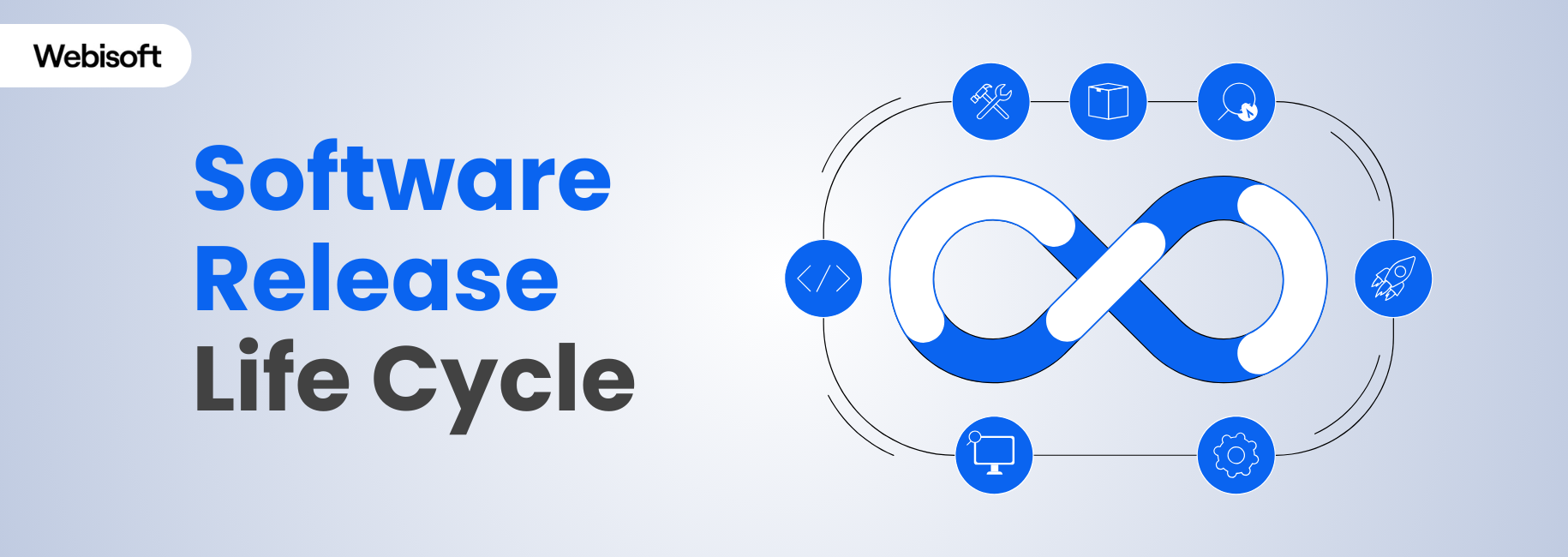The software release life cycle is crucial – As a large amount of software projects fail due to poor release planning. Understanding this process is important for successful software development.
But what is Software Release Life Cycle?
The Software Release Life Cycle is a series of steps that software goes through from when it’s first created until it’s made available to users. It includes planning, building, testing, and releasing the software, ensuring it works well and is bug-free.
In this detailed guide, we’ll explore the different stages of the software release cycle. We’ll break down each step from the initial pre-alpha phase to the final production release. We’ll also address the challenges that may arise and help you with the insights. So Let’s Start!
What is the Software Release Life Cycle (SRLC)?
The Software Release Life Cycle (SRLC) is a series of stages that software goes through from when it’s first created until it’s given to users. It then undergoes updates and improvements over time.
This cycle ensures software creation is organized, checked for issues, and ready for use. It’s a crucial step in delivering high-quality software products.
Different software might move through this cycle quickly or slowly. It depends on what it’s for, what rules it has to follow, how fast things change in technology, and what users want.
This cycle is a bit like another process called the Software Development Life Cycle (SDLC), which is all about making the software. But the SRLC is more than just making. It’s also about making sure the software works well, getting it to users, and keeping it up-to-date.
Having a cycle like this is important because it means that when new software or updates come out, they’ve been properly checked and fixed up. This ensures they won’t cause problems for users.
Contents
The Stages of Software Release
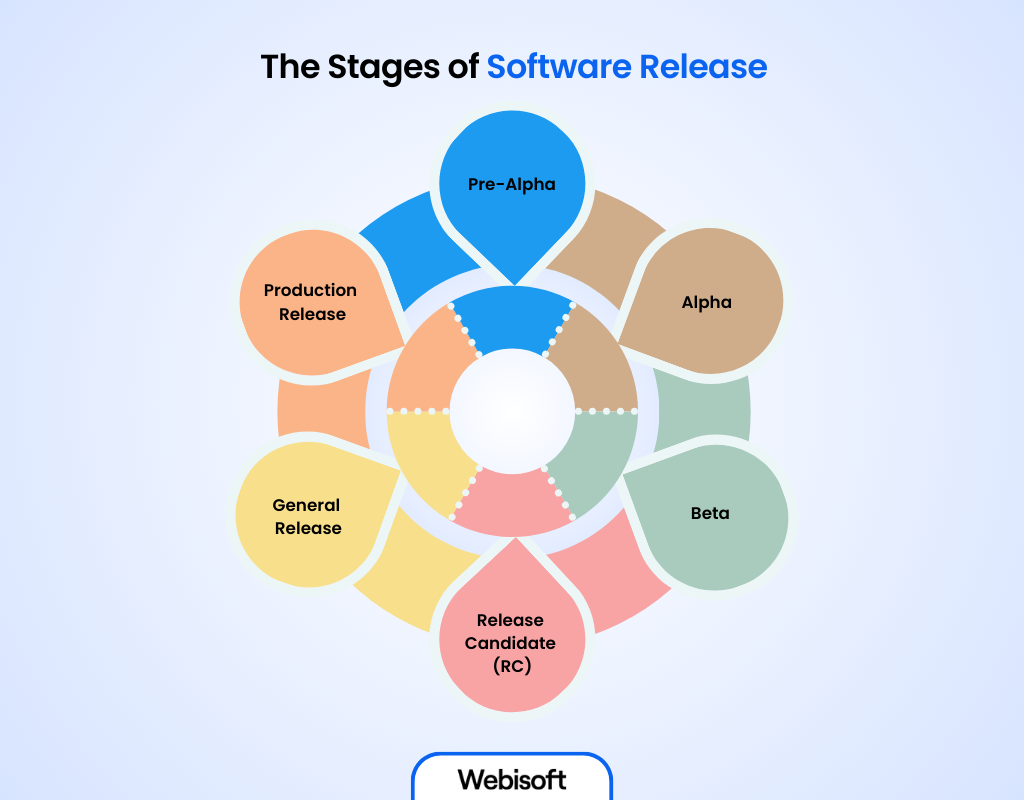
The stages of software release outline a structured path from the initial concept of a software product to its launch and ongoing updates. Each stage focuses on specific goals to ensure the software is developed, tested, and released effectively, meeting the users’ needs and maintaining high quality.
Here’s a closer look at each stage:
Pre-Alpha
The pre-alpha phase is the starting point of making software. It’s where the team figures out what they want to make and how they will do it. This includes:
- Research: Looking into what’s out there, what people need, and what kind of software could meet those needs. It’s about understanding what will make the software useful and who will want to use it.
- Planning: Once there’s a good idea of what the software should do, the next step is to plan out how to make it. This involves deciding on the steps to take, the tools and people needed, and how long it might take to get it done.
- Design: With a plan in place, the next thing is to design what the software will look like and how users will interact with it. This is about making sure the software is not only functional but also easy and pleasant to use.
- Development: This is where the coding starts. Developers take the designs and start building the actual software, adding features, and making sure everything works together as it should. This stage is all about turning the ideas and designs into a working product.
Alpha
After all the groundwork in pre-alpha, the software moves into the alpha phase. This is the first time the software starts to look and act like the final product, but it’s still not ready for the outside world.
The alpha version is pretty rough around the edges. It has the main parts of the software working, but there are lots of bugs and things that don’t work right yet.
Testing at this stage is mostly done by the people making the software. They’re looking for big problems that need to be fixed to make sure the software does what it’s supposed to do.
Beta
After the alpha phase, the software enters the beta phase, which is closer to the final product but still in testing. Now, the software is stable enough to perform its main functions, though there might still be some bugs. The goal here is to refine the software as much as possible.
During the beta phase, the software is shared with a select group of users who fit the target market. These beta testers use the software in real-life scenarios and provide feedback on their experience.
This feedback is crucial for identifying any unseen bugs and understanding how the software meets user needs. The focus is on improving the software based on this feedback to ensure it’s as good as it can be.
Release Candidate (RC)
Next comes the release candidate phase, where the software is nearly ready to launch. After incorporating feedback from the beta phase, the software undergoes one last round of thorough testing.
This testing, often done by the development team, ensures that all parts of the software work perfectly and that any remaining issues are resolved. It’s about making sure the software is reliable and ready for a wider audience.
General Release
Then, the software reaches the general release stage, where it’s made available to the public. This stage follows extensive testing and improvements. Now, the focus shifts to marketing and distributing the software, making sure it reaches the intended users and meets their needs.
This is the moment when the software officially goes live, ready for users to download, purchase, and start using.
Production Release
The production release is when the software is not only available to everyone but is also shown to be stable and trustworthy. This is the version that everyone uses, and it comes with ongoing updates and fixes to ensure it keeps running smoothly.
Generally, there are two types of stable releases. Regular updates that maintain the software’s smooth operation. Long-term support versions for users who want the reassurance that their software will stay consistent over time.
Alpha vs Beta vs Release Candidate
Here’s a table summarizing the key differences between the Alpha, Beta, and Release Candidate (RC) phases in the software development lifecycle:
| Phase | Purpose | Testing | Users | Feedback and Iteration |
| Alpha | First test to fix big problems. | Done by the team making the software. | Just the team and maybe some other company people. | Used to change a lot and make the software better. |
| Beta | Test with real users to find more bugs and get their opinions. | Done by people outside the team. | A few chosen users from outside. | Used to make final tweaks and fix minor issues. |
| Release Candidate (RC) | Final step before official release. | Final check for any big problems. | More people, like testers and some stakeholders. | Last chance to fix anything wrong before general release. |
The Software Release Process
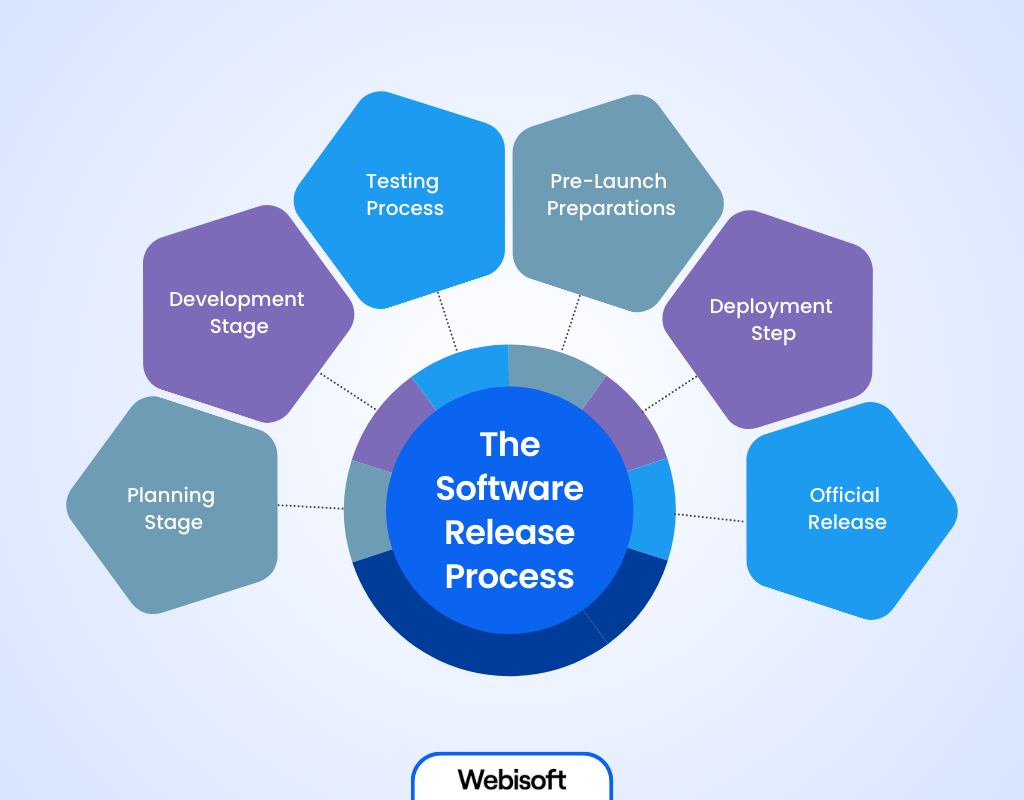
The software release process is how a software idea gets turned into an actual program that people can use. Let’s go through the steps in simple terms:
Planning Stage
At the start, teams lay the groundwork for the software. They decide what the software will do, how it will work, and what it will look like.
They figure out what resources they need, and how long things should take, and create a plan that outlines everything. This step makes sure everyone knows what they’re working towards and how they’re going to get there.
Development Stage
Now, it’s time to build the software. Coders start writing the software’s code, and designers focus on making it user-friendly and appealing. Everyone works together, using the plan as a guide, to turn ideas into a working piece of software.
Testing Process
This part is all about checking that the software works the way it’s supposed to. The team tests everything, from small parts to the whole system, to find and fix any problems. This careful checking makes sure the software is reliable and does what it needs to do for the users.
Pre-Launch Preparations
As the software gets close to being finished, this phase is for tying up loose ends. The team makes any last-minute changes needed after testing, gets the help documents ready for users, and starts telling people about the software.
Sometimes, they let a small group of real users try it out and give feedback, which can lead to final Modifications.
Deployment Step
Here, the team gets the software out to users. This might mean setting up servers, putting the software online where people can get it, or updating systems with the new software. The goal is to make sure this goes smoothly so that users can start using the software without any trouble.
Official Release
This is when the software is finally out there for everyone. The team promotes the software to get people interested and using it.
Even though this is a big achievement, the work isn’t over. The team keeps improving the software, fixing any new problems that come up, and adding new features based on what users say they need.
Challenges of Software Release
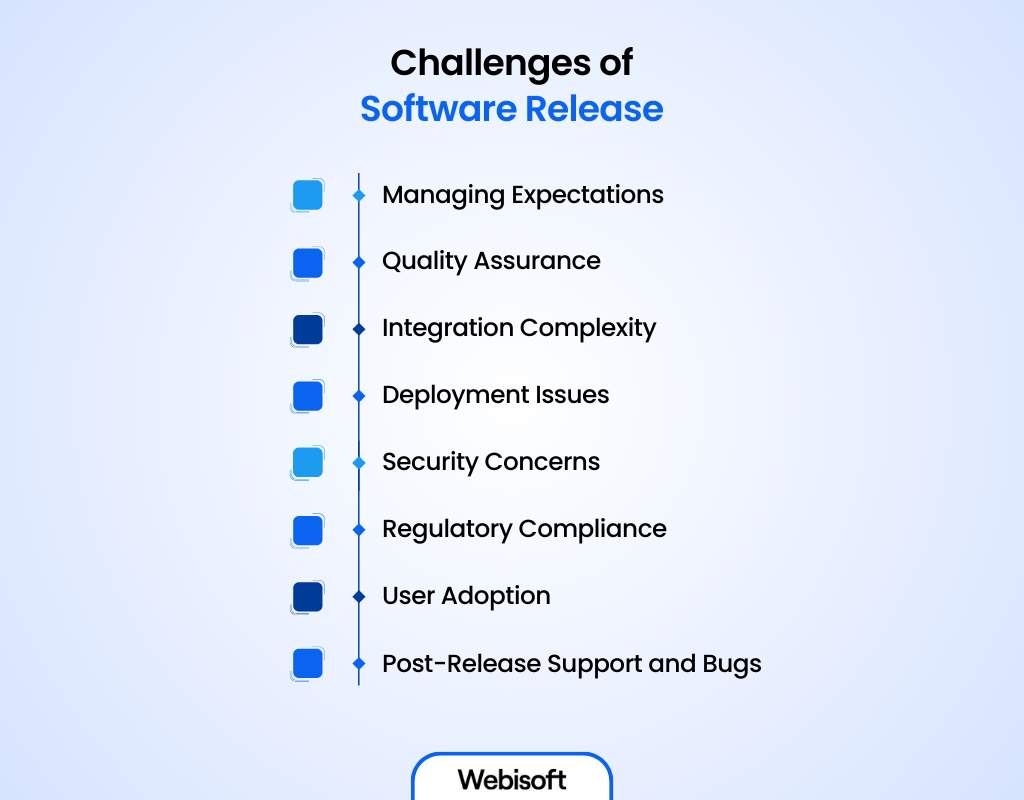
Releasing software can be tricky and involves overcoming various limitations. Here’s a straightforward look at the main challenges:
Managing Expectations
Balancing stakeholder expectations, including those of customers, managers, and the development team, can be difficult. There’s often a gap between what users want, what can be delivered on time, and what is needed.
Quality Assurance
Ensuring the software is bug-free and performs well under various conditions is a major challenge. Comprehensive testing must be balanced with the release schedule. This often entails tough decisions regarding which issues are fixed for the release and which are deferred.
Integration Complexity
Integrating new software with existing systems, databases, and applications can introduce unexpected challenges. Compatibility issues may arise, requiring additional work to provide seamless operation.
Deployment Issues
The actual deployment of software, especially in complex environments or across multiple platforms, can present unexpected obstacles. Configuration issues, hardware compatibility, and network problems can all impact deployment.
Security Concerns
Protecting the software and user data from potential security threats is significant. Identifying and mitigating vulnerabilities before release is critical, but it’s challenging to anticipate all possible security issues.
Regulatory Compliance
For many applications, especially in sectors like finance, healthcare, and education, software must comply with numerous regulations. Ensuring compliance without compromising functionality or user experience requires careful planning and execution.
User Adoption
Convincing users to adopt new software or updates, especially if it significantly changes their workflow or if the previous version had issues, can be difficult. Effective communication and support are essential to facilitate user adoption.
Post-Release Support and Bugs
After release, addressing user feedback and bugs quickly is crucial for maintaining trust and satisfaction. Balancing ongoing support with the development of new features or products requires careful resource management.
How Webisoft Can Help in Improving Your Software Release?
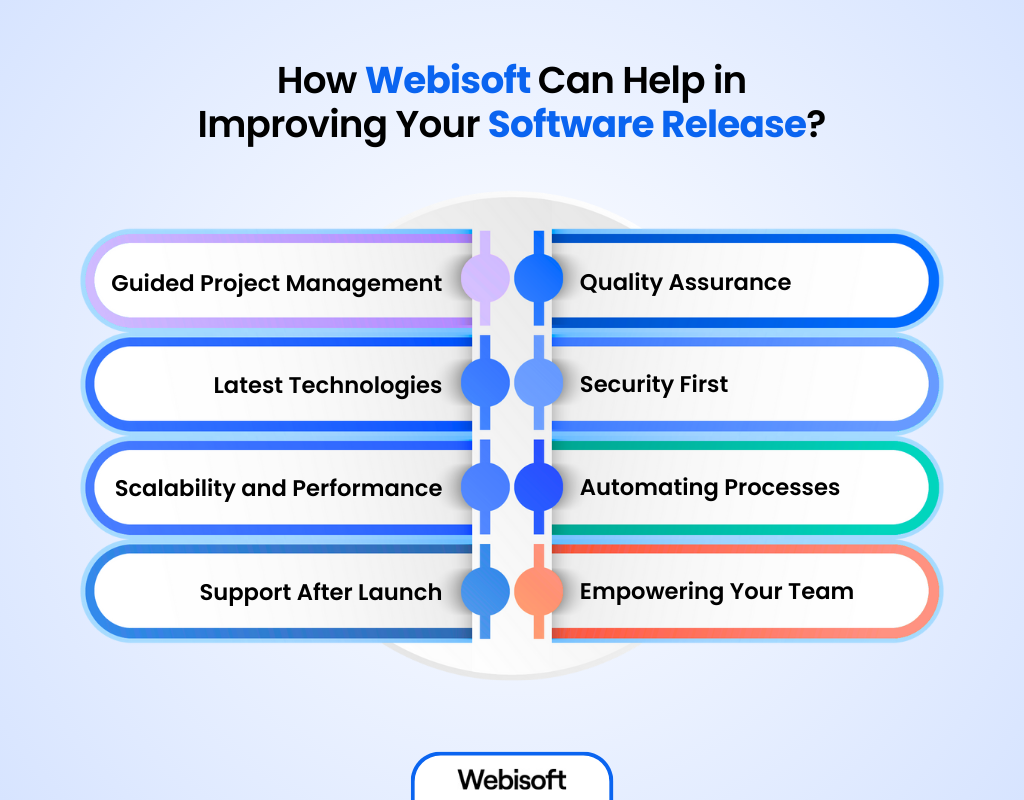
At Webisoft, we focus on improving your software release processes. We ensure it’s easy, fast, and results in a product you’re excited to deliver to your users. Let’s explore how we can help:
Guided Project Management
We provide expert project management to keep your software development on track. From the beginning, we help plan your project, set realistic timelines, and ensure we meet deadlines without compromising quality.
Quality Assurance
Our dedicated Quality Assurance (QA) team plays a vital role in ensuring your software is top-notch. We conduct thorough testing at every stage of development to catch and fix any issues early. This means when it’s time to release your software, you can be confident it’s working perfectly.
Latest Technologies
At Webisoft, we use the latest development frameworks and tools to make your software better and get it to market faster. Our expertise means your software is built using the most efficient, secure, and innovative approaches available.
Security First
We integrate security measures from the beginning of the development process to protect your software against threats. Plus, we ensure your software complies with all relevant security standards and regulations, giving you and your users peace of mind.
Scalability and Performance
We know your software needs to grow with your business. That’s why we focus on scalability and performance from day one. We ensure your software can handle more users and more data over time, without slowing down or crashing.
Automating Processes
Our Continuous Integration and Continuous Deployment (CI/CD) practices mean your software is always ready to evolve. We automate testing and deployment, which speeds up the release process and makes it easier to make quick improvements based on user feedback.
Support After Launch
Once your software is launched, we offer ongoing support and maintenance to address any issues swiftly and keep your software up-to-date. This includes security patches, bug fixes, and new features to keep your users happy.
Empowering Your Team
We believe in empowering our clients. We offer training and knowledge sharing so your team can manage and update the software with confidence. We’re here to support you, but we also want to build your in-house expertise.
Conclusion
To wrap up, we’ve explored the various stages of the software release life cycle, from pre-alpha to production release. Understanding this process is crucial for successful software development.
As we look to the future, the importance of mastering the software release life cycle only continues to grow. With technology rapidly advancing and competition getting fiercer, staying ahead requires a solid understanding of this process.
Ready to take your software release process to the next level? Contact Webisoft today and learn how we can ensure your next software release not only meets but exceeds user expectations.
FAQs
What is RC in software release?
RC stands for Release Candidate, which is a version of software nearly ready to be released, needing final checks to ensure it’s free of critical bugs.
How do alpha and beta versions differ from the final release?
Alpha and beta versions are early versions used for testing and feedback. They’re not as complete or polished as the final release, which is the finished product.
What comes after beta testing in software development?
After beta testing, the software moves to the Release Candidate (RC) phase, where final adjustments are made before the official release.
What is the cycle time of software release?
The cycle time of a software release is the total time taken to develop and release a new version of the software, varying greatly depending on the project.
What is a release framework?
A release framework is a structured approach or set of guidelines followed to manage and execute the release of software from development to deployment.
